Supporting food security through vegetable box schemes.
How buying fruit and veg from a box scheme can support a long-term shift to the existing broken central food system.
A decentralised food system gives control back to farmers/growers/producers, to manufacturers in the value chain, and to you as a citizen. The current central food system is one involving lots of middlemen, where the farmer gains only 1% profit on the food they grow, and you as a consumer are unaware of the journey your food has taken, not least the concoction of pesticides used on it. Shifting the system to one that promotes and nurtures shorter local supply chains can only serve to protect livelihoods, our health, our wallets, and our land, water and energy usage.
In this article I take you through what a sustainable food system could and should look like, and how you can easily take action as a citizen by participating in a vegetable box scheme.
What does decentralisation mean?
Though it may not seem as if there is a central hub, the way our current food system operates is as if the supermarkets are the main hub, while farmers, packers and consumers are just the strands. The supply chain is in fact so multi-layered and complex that there could never be a centre, yet the supermarkets have control of orders — quantities, quality, pricing. Surely you’re aware of the wonky veg rationale that supermarkets give?
Decentralisation gives control back to those who produce, and subsequently to those who consume. By removing the central hub, there is in fact smaller hubs across shorter supply chains, making them more regionally and nationally accurate. Shorter, decentralised supply chains allow a direct relationship to form between farmer, value chain producers, and the consumer. There grows more respect and understanding throughout.
What does food security mean?
Food security considers that we are secure in our access to food. Be that the ability to afford supermarket food or have land to grow our own, the food needs to be reliable. It’s also useful if it’s nutritious.
With rising catastrophic climate changes, rising living costs, depletion of soil health, introduction of more genetically modified and edited crops, war and natural disasters, it is increasingly difficult to find stability within the food system. Each country has its own policies for import and export too, and with a rapidly growing population yet a need for more stuff, land is being given over to things other than healthy agriculture.
Why is decentralisation of the food system helpful?
As there is a reduction in national (or global) storage, transportation and distribution needs, decentralisation reintroduces seasonality. You would only realistically be able to purchase produce that is in season for where you are located. Seasonality inherently engenders value and desire. That being said, seasonal really needs to be seasonal, as in, what would naturally grow in the climate — this doesn’t mean tomatoes in December in a heated greenhouse.
Decentralisation also allows producers to go direct-to-consumer if they wish, so improving margins. Removing the middlemen across the chain can be useful when it means cuts to profit — the less people involved, the higher the margin, and so the higher the profit. While it could involve more logistical frameworks for the producer by not going direct to supermarkets, the Covid-19 pandemic actually showcased dramatically how tech (And community initiatives) can quickly allow businesses to be agile.
With decentralisation, you as the customer are more privy to the produce origin; though packaged supermarket food - and indeed some grocery stores - have origin labels for produce, this information is very basic and doesn’t tell you if pesticides were used, how the produce was transported, and who the farmer was. It’s not fully traceable regardless of these labels, as each country has their own regulations, and what if you select a carrot from the incorrect box? Remember the horse meat scandal too?
Lastly, embedding a culture of short local supply chains gives us as consumers agility too; we’re not totally dependent on supermarkets for our produce, starkly highlighted with Brexit, ships blocked in the Panama Canal, all of the pandemic, and again as the war on Ukraine disrupted supplies. These short supply chains also includes growing your own, so even then you’re not dependent on farmers who are also dependent on the weather.
What is a sustainable food system?
I’ve introduced how decentralisation can support both us and farmers. This system obviously doesn’t work for supermarkets, and of course there is the argument of job loss should supermarkets no longer be able to operate as is, but a shift in the system still allows for transferable skills. A sustainable food system involves radical thinking and action, and frankly is the only way we can survive — socially, environmentally and economically. Decentralisation is key to this.
According to the Sustainable Food Trust: “for every pound UK consumers spend on food, an additional hidden cost of 97p is incurred”, in serious environmental and health-related costs including the price of mitigating and adapting to climate change.1 ~ The Hidden Cost of UK Food report, 2017.
To me — as with anything “sustainable” — a sustainable food system must obviously sustain itself. Regardless of disruptions, there is a secure supply of food. This looks different according to each country, and especially between the Global North and Global South — what we “need” and what we are used to here in the UK is a privilege.
In an ideal world, all of these points would be hit upon. I asked Notion’s AI to help me with this list, but I rearranged it and you’ll see I added commentary:
Supporting small-scale and regenerative agriculture practices > support in what way? Policies and legislation need to shift, farmers need evidence of the feasability, more training needs to be conducted.
Investing in research and development of sustainable agriculture technologies > this needs to include traditional and indigenous technologies i.e. hands and slow machinery or animals. Not all communities can or want to access and utilise digital devices.
Promoting local food systems and decreasing dependence on imports > these should be separate in a way, because decreasing dependence on imports relates to policy, while promoting local food can be done in a community.
Increasing access to healthy and affordable food in underserved communities > there are two clear ways here: one is to stop land grabbing and give land back, so that communities are able to grow their own or make income to serve their cultural needs (not the needs of a global market), and two is to increase wages/prevent rapid inflation/improve benefits/improve purchasing habits in schools etc/support urban food growing spaces so that good food can be accessed.
Supporting food cooperatives and community-supported agriculture programs > relates closely with the above point, as dedication towards funding (and allowing) access to land so that cooperatives can run a CSA is integral, otherwise there’s no way communities could afford to do it.
Encouraging food sovereignty and equitable distribution of resources within the food system > you always have to dive deeper with AI suggestions… “equitable distribution” regards, funnily enough, equity being commonplace anyway. If the poorest stay poor, and the richest keep taking, then how will there be an equity of resources in order to encourage food sovereignty?
Reducing food waste by implementing composting and food recovery programs > to a certain extent yes, implement better infrastructure so that food waste can be reduced, but this also requires Extended Producer Responsibility and accountability on the behalf of producers and supermarkets to reduce packaging, which is leading to over-purchasing and produce to go bad.
Implementing sustainable packaging and transportation practices to reduce food miles > as above comment, though also includes a shift away from global food production in order for food miles to have been inherently reduced. On average, transport constitutes around 12% of the UK’s food climate impact2, so isn’t as large a figure as you may imagine, but this figure is just transport - not packaging. Why not just ditch packaging altogether if it isn't required for transport, or find better solutions?
Transitioning to plant-based diets and reducing meat consumption > there’s research back and forth about the impact of both, with one in 2018 stating that meat and dairy uses the vast majority – 83% – of farmland and produces 60% of agriculture’s greenhouse gas emissions.3 A recent 2023 study shows how pastoral grazing could emit as much GHG as a wildlife-dominated savanna4, giving data to the conversation of whether grazing is beneficial (and regenerative) or not.
Promoting food education and literacy to encourage informed consumer choices > though I would agree reducing meat consumption is required, it needs to fall under informed choices; as with all produce there are more nutritional options, it’s just whether we can access and afford them. Make organic and regenerative the norm, and then we have less choice, but there is equity. Or everyone goes hungry anyway because of poor wages and high inflation…
What are vegetable box schemes?
Vegetable and fruit box schemes are mostly found through a weekly subscription basis, where an organisation will procure and collate produce under a specific banner — for instance, organic, wonky, all tomatoes, local from one farm.
They can be delivered direct to your door, or you can collect. The vegetables are mostly seasonal when coming direct from farms, but fruit add-ons usually occur with most schemes because, well, the UK doesn’t really have winter fruit! Veg bags internationally may run differently.
I’ve been a customer of Growing Communities for at least 4.5 years now. It’s the most local to me in Hackney, with a separate Farmers’ Market each Saturday for top ups. It’s not the most exciting, frankly, with winter bags full of parsnips, celeriac and cabbage. But it definitely made me more aware of seasonality, especially when considered next to the produce I grow as part of a team in a London kitchen garden. There’s a swap box, rather than a “ditch list” as some companies have. We actually receive all the non-collected bags and damaged produce at our garden because we have a large composting system, though in fact we sort and save most of it — donating to a local food service, using in our own kitchen, or taking stuff for ourselves. Most of it in winter though is parsnips, celeriac and cabbage.
Over the past few years, costs have been rising for farmers and growers all over the UK and beyond. Food prices in the UK have risen by over 15% in the past year alone. Rising costs have made it increasingly difficult for us to source a good variety of produce, particularly for the smaller bags. We want to continue to pay fair prices to the farmers we work with, while making the bags as interesting and delicious as possible. We’re absorbing some of the rising costs ourselves by reducing our markup on some of the bags. ~ Growing Communities email to members.
The price per bags did rise this year for the first time in 3 years. For the “small no potatoes” bag I get, it was £9.70 per week but now it’s £10.30, and this is for 5 varieties of veg. I would say this is expensive when compared to the supermarket, but not compared to a London grocer, and I know that the farmers are paid a direct fair price for their produce here — and it’s all certified organic. Note: I don’t get potatoes because I don’t want to eat them often enough, they’re easy to find, and prefer the intrigue of what to cook, which means my bag costs more than a “small potatoes bag” as potatoes are cheaper than an alternative veg. We are emailed two days before collection with the bag contents along with recipe ideas and some local food news. This is what last week’s bag included:
GC salad* - Growing Communities, Dagenham/Hackney
Pak choi - Wild Country Organics, Cambs
Leeks - Nacton Farms, Suffolk
Carrots, aubergine - Netherlands/Spain via Langridge
You also then have more knowledge of origin, and awareness that certain crops cannot grow readily here, such as aubergine — or we’re too early in the season for them to be available, yet the small bags need a nice mix.
In total, for every £1 spent by Growing Communities’ customers, we estimate that the scheme generates more than £3.70 of social, environmental, and economic value. Of this extra value, £3.46 is generated for the customer and their household. This includes the value of the food they receive, improvements in health and wellbeing, and time saved due to less supermarket shopping. 32p of value is created for the environment, through better farming practices and changes in customer diets which reduce carbon emissions and improve water quality and wildlife health, among other things. Additionally, 13p of value was created for farmers and processors, and 7p for Growing Communities employees. ~ New Economics Foundation article, 2021.5
Another frank comment is that I’m not a fan of their salads, purely because I am a salad grower and our salads are absolutely banging. We should win an award for them, honestly, they will utterly change your perception of what salad leaves should be. But if I can’t swap the GC leaves (and generally I don’t, as I know they’ll sit wasted in the swap box), then I’ll use them as cooking greens. However, the salad they grow comes from their patchwork farms, three of which are exceptionally local to me, and it’s this ability to pop your head in that can really engage folk in their food origins.
And FYI — I am low income. But I value this food system shift, I respect the effort and energy of growing organically, and I support local community economies. I still have to make the routine decision to purchase an unpackaged vaguely organic £2 broccoli over a packaged 70p supermarket one, but small steps are worthwhile steps.

What does organic refer to?
I mentioned “certified organic” above.
So, I’m an organic food grower — I cultivate the land using organic principles and inputs, which simply means no pesticides (including herbicides, fungicides and insecticides) and no other synthetic inputs. Additionally, organic tends to include a more holistic cultivation, including no-till (churning up the soil), polycultures over monocultures, no GMO (genetically modified organisms) and no peat compost. However, if there is no certification framework in place to cover all the principles, then “organic” can be quite loose. Our garden is not certified — it’s expensive to do so, and we’re only supplying an on-site kitchen, as you’d find with some other small-scale producers. Producers for main veg bags and supermarkets do need the certification, so usually if something is organic in those situations, you’ll find an accredited label.
Some organic certifications also cover ethics, such as living wage, but this isn’t in reference to the produce and more in regards to an holistic system.

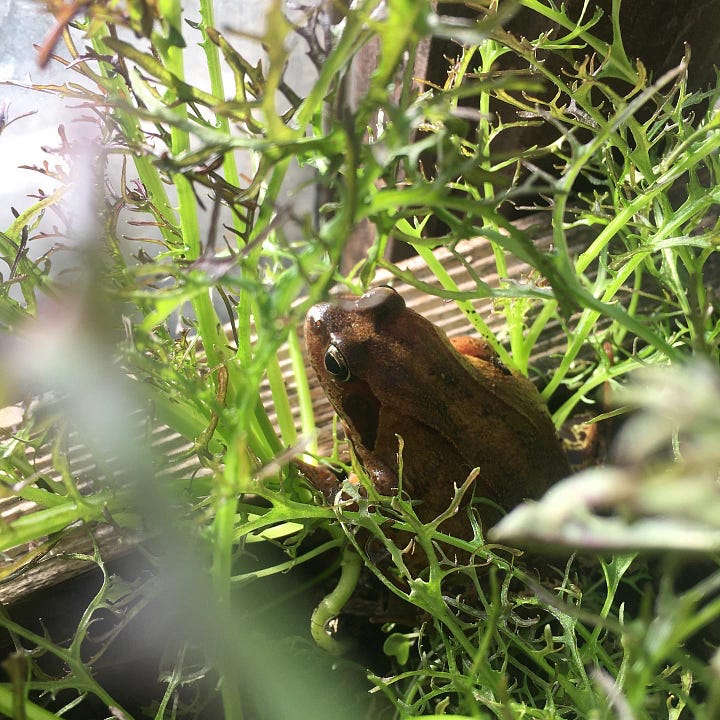
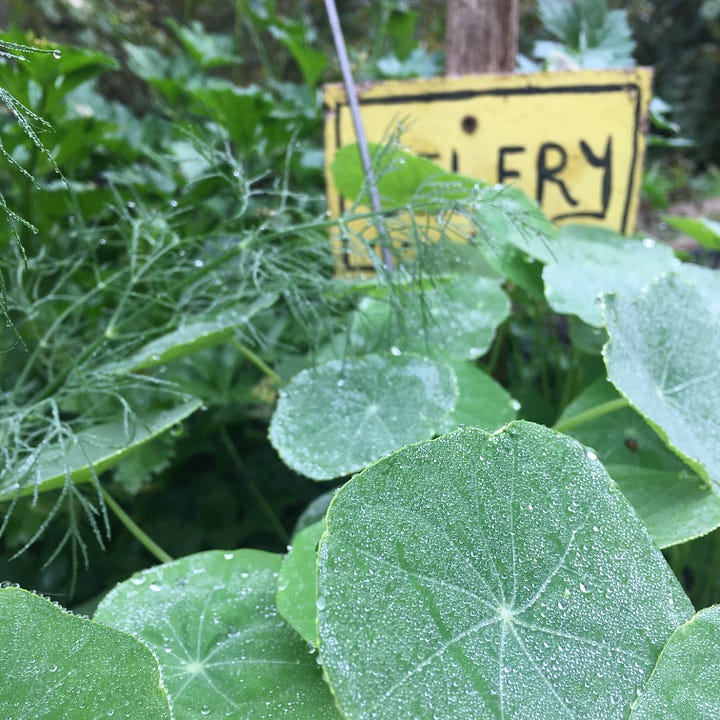

Regional box schemes
I’m highlighting mostly the well-known ones, but you should be able to do a quick research of what’s available in your area. That being said, searching “london veg bags” comes up with schemes I didn’t even know of, while my favourites are on page 3 — maybe I should ask if they want some SEO work doing.
Abel & Cole — they seem to supply mostly from the UK and mainland Europe, with items like bananas from Dominican Republic, unless you select an all British veg box, which I’d actually give a go of myself. I haven’t seen it in person to know if it’s good quality and quantity, but all produce is organic. And they donate (one portion, not a box’s worth) to food charity partners: the Felix Project, Dons Local Action Group and School Food Matters.
All British Veg Box £14.25 for 7 varieties of organic UK veg.
Oddbox — my housemate gets this every fortnight. Sometimes she can’t be bothered to cook and veg is dumped in the food waste box for our compost (for me to sort). I often take veg bits out of here to cook for myself. I’d prefer people just to reduce the size of their bag than waste what was already classed as waste. This doesn’t shift the system! Otherwise, the produce always seems fresh, but somewhat overly packaged because it’s the dregs packaged for supermarkets rather than direct for a box scheme purpose. And so are not organic too.
£11.99 for 9 varieties of veg.
Milk & More — I don’t use a milk float so I’ve never seen this scheme and therefore can’t vouch for it, but I like that you can get all your groceries delivered, and organic too. Helpful for folk who really can’t get to the shop, and would like a relationship with their supplier. There’s other suppliers here, including a refill service for such items as grains from Good Club. Apparently they do deliver to my postcode and I can order up until 9pm the night before.
£16.50 for a standard box (no swaps) with 9 varieties of fruit and veg.
Riverford — they have veg boxes, mixed boxes, salad boxes and meat boxes and again are getting most produce from the UK, Spain, Netherlands, France, Italy and international fruits - though again all-UK options possible. If you don’t get fruit, it’s not bad priced, and they offer a ‘zero packaged’ box for the same price yet with different varieties, which seems a no-brainer when the items are more varied (and an add-on three-variety-zero-waste-surprise bag is possible).
£13.95 for the zero packaging organic small box with 7 varieties.
Natoora — included because it’s swish, rather than because I think it’s accessible and you should use it. Their Peak Season Box looks interesting delivered in the wooden crate, for which you pay delivery for unless you become a member of the 'Radicals’ club, and receive around 11 products (though not many of each type). They have nice pictures of some of their growers. Natoora do source for restaurants, but switched to home delivery during 2020 for obvious reasons. So if you want a posh box, along with some other posh products, and like using apps, then this could be fun to try.
£35 for 11 varieties.
There’s this review of more from BBC Good Food if you want to research more available boxes and pricepoints.
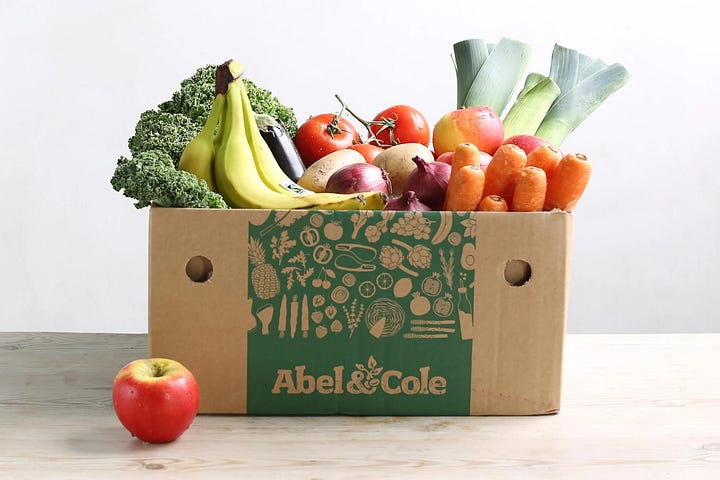
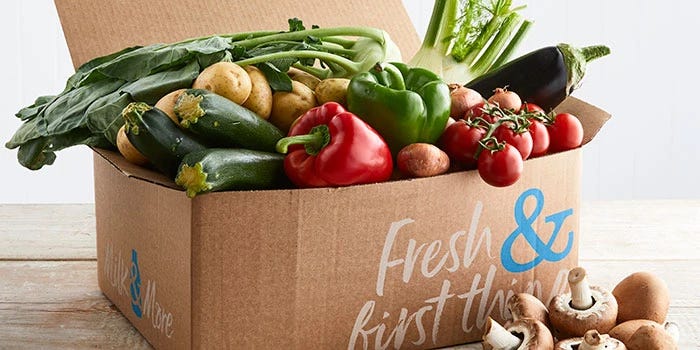
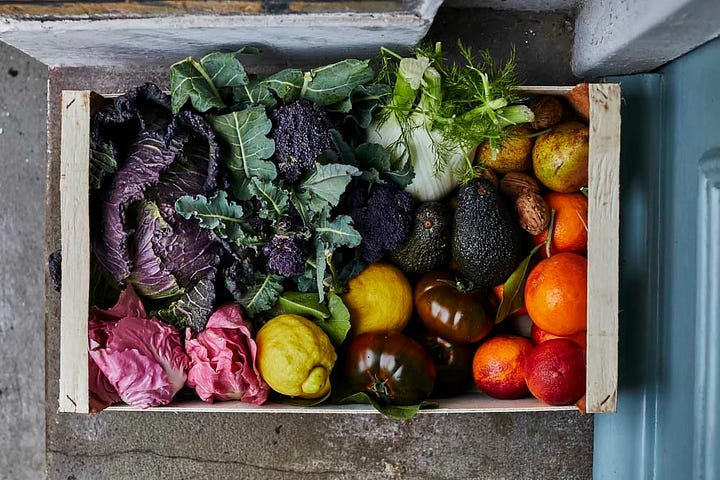
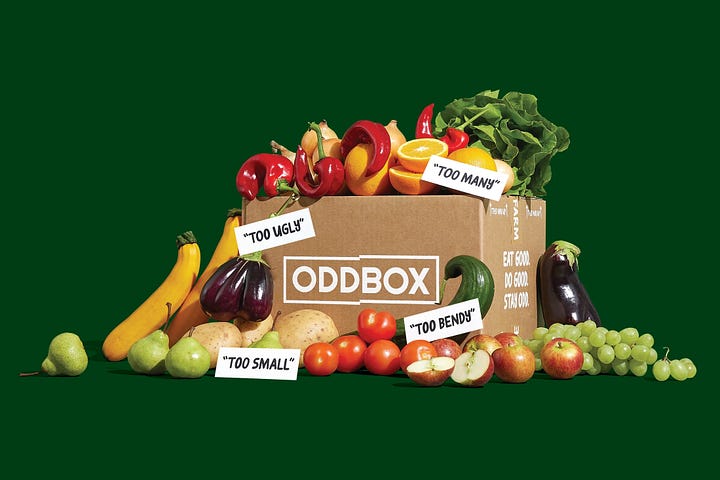
London box schemes
Kentish Town Veg Box — they have collection points only in North London and only source from the UK, which means they have a fruit supplement due to this, and so it really is seasonal. They also class themselves as fair trade, stating that farmers they source from get 60% of the veg box pound spent (as opposed to 10% via a supermarket). I like that they use reusable tote bags rather than plastic (like Growing Communities do), and offer a 20% discount for those on low income.
Farmaround — I hadn’t heard of these, but they deliver to London, Brighton and the South East, though have a Northern Farmaround set up for up there. The founder Isobel started this in 1994 as London’s first veg box, and then went on to save 600 sheep from slaughter to transform their wool into clothing for brand Izzy Lane. Though they have a super simple website, they allow you to select a one off - useful if you’re just exploring the options.
Sutton Community Farm — for South London and Surrey only and are another one where you can select a one-off, along with other produce through their online farm shop. They’re a community enterprise, heavily supported by volunteers, and are in the midst of a crowdfunder to raise £50,000 to keep the farm going - with £15 for a farm tour and lunch, or £1500 for a team challenge day. It’s worth noting that choosing a scheme to stick with and provide weekly payments to gives a more stable income for the scheme and their suppliers.
Organiclea — a workers’ cooperative in the Lea Valley with most produce for the boxes coming directly from their growing site in Chingford, with pick up points across Waltham Forest. They also hold open days and volunteering if you fancy a trip up there (it’s far from the city…).
Enfield Veg Co. — for Enfield and East Barnet only with collection points across the borough. They run out of Forty Hall Farm, a market garden led by Capel Manor College. And just for interest, they house rare sheep breeds at the Enfield site.
Local Greens — based in Herne Hill, they supply weekly bags to Lambeth and Southwark boroughs. It seems that you’d have to weigh your veg via one scheme to get an idea of what the other schemes really offer, as it could look like one is better value in terms of relative ‘small bags’, but not be as varied or quality.
Growing Communities — I’ve already mentioned, but for clarity, they have 30 self-service collection points across Hackney and Haringey so you can collect as a convenient time. They also founded and are a member of the Better Food Traders, a UK-wide support network of ethical food retailers.
⇾ The issue with some London schemes is that collection points get full and you need to go on a waiting list. If you find one that is most convenient for you, use the opportunity to try other bags in the meantime to get an understanding of pricing, quality and quantity.
⇾ For anyone who travels outside of the city, or lives outside and commutes in, it could be worth checking the suppliers of these London schemes as most farms offer their own boxes. Find a full list of organic box schemes via Soil Association.
⇾ And if you do have a local farmers’ market, make the journey to there instead. If you’d be going to the supermarket anyway, shift your habit.
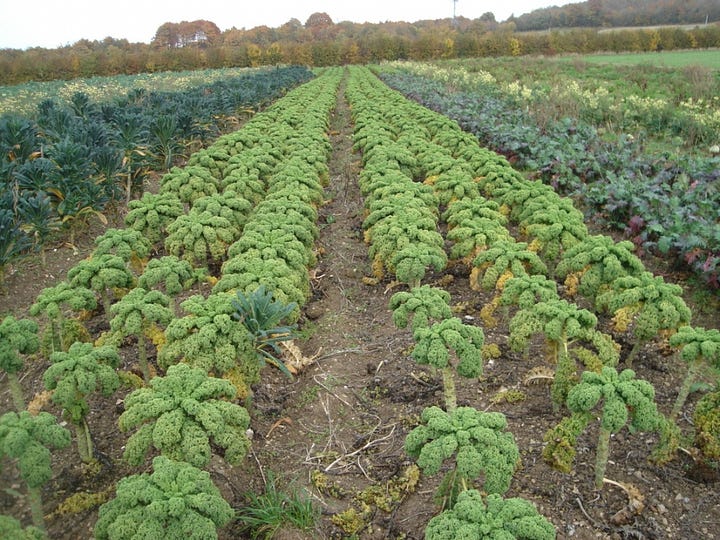
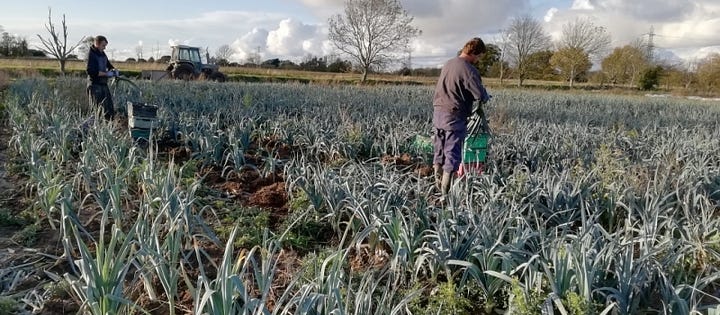
What are the benefits of a vegetable box scheme?
Here’s your bullet list of a few reasons:
Farmers are paid a fair price, without haggling. They can then invest in their farm infrastructure, diversify their product offering, hire employees. Since working with Growing Communities, farmers reported that their annual turnover increased by an average of £50,000.
An ethical model would mean that scheme employees are paid a living wage, and usually want to further support a decentralised food system. Generally they’re part of a Community Supported Agriculture model too where the customers and growers are shareholders.
Box schemes mean less visits to the supermarket, especially when you know in advance what you’re receiving or can alter your likes. Subscriptions can also be paused while on holiday, or donated in kind to a food bank.
Most come minimally packaged, so in comparison to the supermarket, you’re not paying for unnecessary pollution. And any packaging can usually be reused — cardboard for your compost browns, salad bags for freezer bags.
Apart from giving the finger to supermarkets, you are helping a shift towards a decarbonised, decentralised and local economy where control is in the hands of the many not the few.
Community supported agriculture is a model that works globally, it just takes the grassroots actions to scale the practice in multiple locations.
You know where your produce is coming from, right down to the farm’s name. You don’t get that in a supermarket or a grocer. This leads to awareness of origin when shopping elsewhere, and understanding of transportation.
Awareness of seasonality and ability to be package-free passes through into the rest of your meals, so the awareness grows further.
It’s not particularly going to directly help folk in the Global South, but a shift to a more decentralised food system will help local economies emerge out of changing policies. It won’t affect local poverty until Governments stand up, because really, your likely privileged purchase of a veg box over plastic-wrapped supermarket food will stay privileged until it’s more the norm. But the schemes that offer donations can add to the pressure.
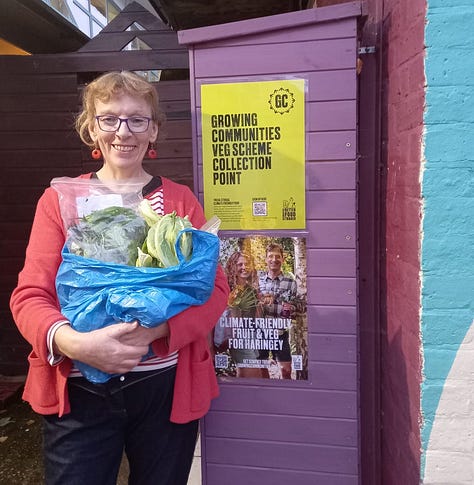

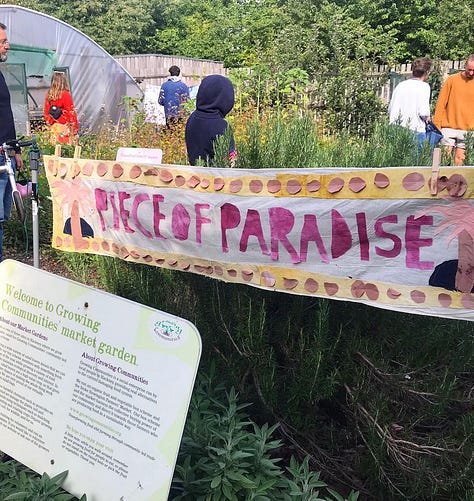
The Hidden Cost of UK Food report, 2017 [Sustain]
FCRN, 2015, Foodsource Chapter 3. Food systems & greenhouse gas emissions
Reducing food’s environmental impacts through producers and consumers (Poore & Nemecek, 2018)
Comparable GHG emissions from animals in wildlife and livestock-dominated savannas (Manzano, Prado & Pardo, 2023)
Community food systems should be part of the new normal – here’s why (article New Economics Foundation, Christian Jaccarini, 2021)





